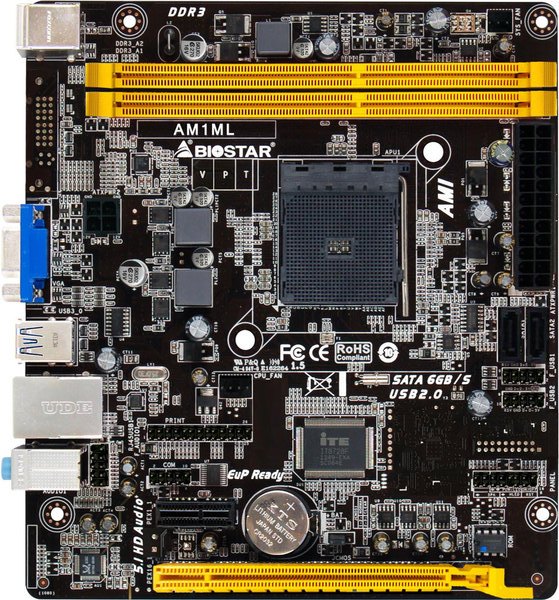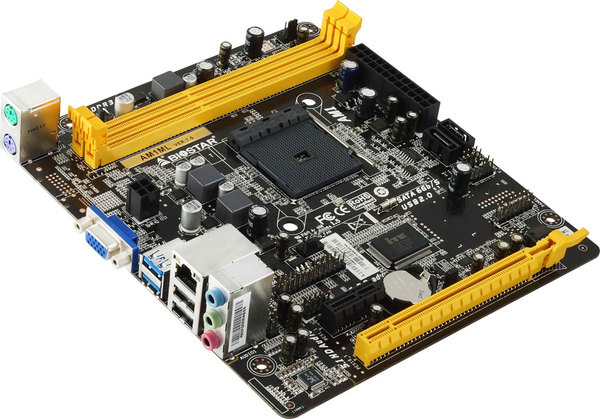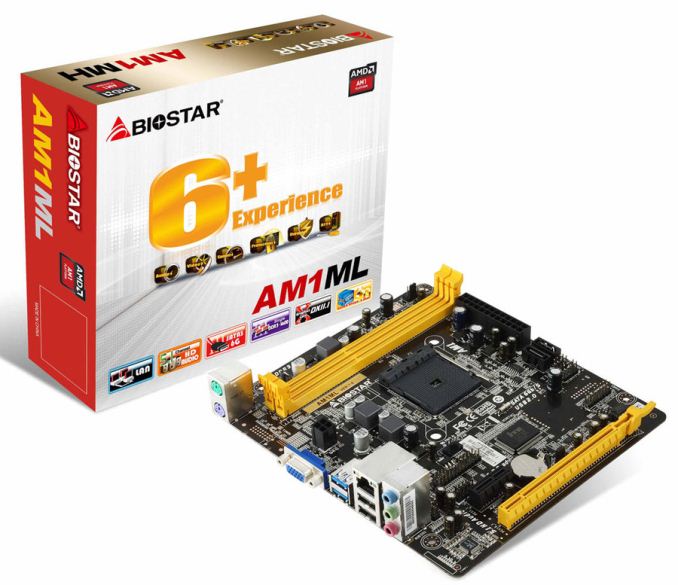The AM1 Kabini Motherboard Preview: Analyzing the Hardware
by Ian Cutress on April 19, 2014 2:00 PM ESTBiostar AM1ML
Every so often at AnandTech we review a Biostar motherboard, and sometimes we get some exciting features (the first manufacturer to test fan profiles in the BIOS) but they mostly end up as a budget play in a market with plenty of players. As part of the AM1 release Biostar hase two motherboards on sale, the cheapest of which is this AM1ML coming in at $33.
Straight off the bat the AM1ML does a couple of things differently compared to a regular motherboard:
First thing I noticed was the arrangement of the DRAM slots. Horizontal placement on a small form factor motherboard has been attempted by ASRock in the past on their channel range, but this type of arrangement is usually restricted to server type builds.
Second was the motherboard size. In my mind I immediately said mini-ITX, however on closer inspection this motherboard is essentially a mini-ITX ‘plus’. It contains the standard 17cm x 17cm layout of a mini-ITX, plus a couple more at the bottom, but not enough for a microATX. This means that this motherboard will not fit in mini-ITX cases unless the case has room for a dual-slot GPU. As a result of this configuration, we get a PCIe 2.0 x1 slot alongside the full-sized x4 slot.
As with many small form factor boards, my ire is often pointed at the location of the CPU power connector. Biostar has it placed near the rear IO of the motherboard, causing cables to be stretched over the motherboard (or DRAM, CPU or GPU). This is ultimately bad planning by an engineer who has a different idea about small form-factor systems than I do. As this is the cheapest AM1 motherboard on Newegg today, there is no surprise that we get the bare minimum. Two SATA 6 Gbps ports, two USB 3.0 ports, and there is even room for a printer port and a COM port.
The back panel is essentially bare, with support for separate PS/2 peripherals and a single VGA port for video output.
Perhaps a surprising kicker is the Ethernet port. Biostar are using a Realtek RTL8106E, which as codenames go is pretty generic, but this is a 10/100 Ethernet port. I never thought I would ever see a socketed motherboard in 2014 ship with a less-than-gigabit Ethernet port. My mind is blown.
The audio is subsequently bottom of the barrel as well – the ALC662 is commonly used on low cost platforms and laptops.
| Biostar AM1ML | |
| Price | Link |
| Size | Mini-ITX Plus |
| CPU Interface | FS1b |
| Chipset | AMD Kabini |
| Memory Slots |
Two DDR3 DRAM Slots Supporting 16GB Single Channel, Up To 1600 MHz |
| Video Outputs | VGA |
| Onboard LAN | Realtek RTL8106E - 10/100 |
| Onboard Audio | Realtek ALC662 |
| Expansion Slots |
1 x PCIe 2.0 x16 (at x4) 1 x PCIe 2.0 x1 |
| Onboard SATA/RAID | 2 x SATA 6 Gbps |
| USB 3.0 | 2 x USB 3.0 (Chipset) [back panel] |
| Onboard |
1 x LPT Header 2 x USB 2.0 Headers 2 x SATA 6 Gbps ports 1 x Front Audio Header 1 x Front Panel Header 2 x Fan Headers 1 x COM Header |
| Power Connectors |
1 x 24-pin ATX 1 x 4-pin CPU |
| Fan Headers |
1 x CPU (4-pin) 1 x SYS (3-pin) |
| IO Panel |
PS/2 Mouse Port PS/2 Keyboard Port VGA 2 x USB 3.0 2 x USB 2.0 1 x NIC (10/100) 3 x Audio Jacks |
| Product Page | Link |
For $33, the Biostar AM1ML gave me a few surprises on the hardware side of the equation. I do not imagine we will have time for a full review to test performance or software, but cheap is cheap.














64 Comments
View All Comments
coolhardware - Monday, April 21, 2014 - link
Sorry for the error on my part, I got the 5150 and 5350 mixed up :-(As per your original post, where did you see that nice 5150 OC? With an ASUS board should the same type OC be possible with the 5350?
Thanks!
yannigr - Tuesday, April 22, 2014 - link
At techpowerup. http://www.techpowerup.com/forums/threads/amd-kabi...But overclocking on this platform is still a big question mark. At Phoronix for example they also tried to overclock ALL the four processors available on the same motherboard and in ALL cases they had stability problems over 105MHz bus speed. So more time is needed to have a definite idea about the overclocking potential on this platform.
As for 5350 I don't know what frequency it can reach. 2100MHz should be easy I guess with just a multiplier change from 20.5 to 21, gut it does make you wonder why AMD didn't gave 5350 the 21 multiplier in the first place.
tech6 - Sunday, April 20, 2014 - link
The problem with the Kabini platform is that it makes too many sacrifices for too little gain. You can buy an Intel G3220 and an MSI H81M mobo for around $100 and while it may consume 10-15W (on paper) more power it will give you about twice the CPU power.As for real world power consumption, I recently build a G3220 system and even when under 100% max CPU and GPU compute using Hash Suite it never exceeded 60W. Under most everyday loads it used about 40W. Given these numbers it is difficult to make a case for the Kabini platform.
savagemike - Sunday, April 20, 2014 - link
I was contemplating similarly. I also wonder with the increased compute power if getting to idle quicker doesn't also attack any power savings.yannigr - Monday, April 21, 2014 - link
You gone from $60 to $100. This isn't "too little gain". Also you forget that the Kabini platform does have better graphics. Much better graphics. And I am not talking (only) about performance, but compatibility also.So, if you need cpu power and you have $100 you can go for Intel. But if you want a better balanced solution in gpu-cpu performance and keep $30-$40 in your pocket, Kabinis are the best option.
mikato - Wednesday, April 23, 2014 - link
I agree.Carleh - Tuesday, April 22, 2014 - link
Does the G3220 support hardware accelerated video decoding?It does support quicksync, but I'm not sure if quicksync can be used for hw accelerated video playback in all applications (flash includeed).
I know the G3220 is powerful enough to do all the decoding in software, but I see no point in using software video decoding in 2014.
Chicken76 - Sunday, April 20, 2014 - link
I remember from the slides that were presented by AMD at launch, that ECC RAM (unbuffered) was supported. Why isn't there a single motherboard that supports it? In it's current form, Kabini is not an option for building a cheap ZFS storage box.Death666Angel - Sunday, April 20, 2014 - link
Why does the motherboard need to support ECC RAM? I'm pretty sure they are physically identical to normal RAM and since the SoC handles all memory (as with most modern CPUs/APUs), the motherboard has no say in it.Chicken76 - Sunday, April 20, 2014 - link
I'm not sure, but if you're not using error correction on a DIMM, do you still need all the traces? They might not have them all in place, to keep costs to a minimum.Besides, you still need BIOS support for ECC.